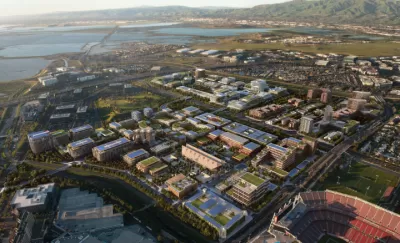Despite the economic uncertainty and reports of a massive upheaval in patterns of living and working in the United States, developers are continuing to spend billions of dollars on massive development projects all over the country.

Kim Slowey details the status of mega-project development around the United States, as the country deals with the economic fallout of an ongoing public health crisis after a decade of steady growth in the mega-project market. According to an FMI Corp study published in the fall of 2019. The annual value of mega-project startups increased from 3 percent to 33 percent over the past decade.
"As the COVID-19 outbreak hit, many massive, mixed-use projects were in various stages of development. For those that were already underway, the pandemic hasn't seemed to significantly change developers' decision-making," explains Slowey before checking on the status of the country's largest mega-projects, including an $8 billion development by Related Cos. in Santa Clara, the $6 billion Lincoln Yards project by Sterling Bay Companies in Chicago, the $5.5 billion Port Covington development by Weller Development in Baltimore, and more. Other mega-projects listed in the article are found all over the country—from Rochester, Minnesota to Atlanta to Islip, New York to Frisco, Texas.
"It remains to be seen, however, what the ultimate effect will be as remote working has gained popularity, and potential tenants and residents have eschewed urban living for the suburbs in order to gain some physical distance from each other," writes Slowey.
FULL STORY: Crane watch: 7 mixed-use projects costing mega-billions

Planetizen Federal Action Tracker
A weekly monitor of how Trump’s orders and actions are impacting planners and planning in America.

Congressman Proposes Bill to Rename DC Metro “Trump Train”
The Make Autorail Great Again Act would withhold federal funding to the system until the Washington Metropolitan Area Transit Authority (WMATA), rebrands as the Washington Metropolitan Authority for Greater Access (WMAGA).

The Simple Legislative Tool Transforming Vacant Downtowns
In California, Michigan and Georgia, an easy win is bringing dollars — and delight — back to city centers.

The States Losing Rural Delivery Rooms at an Alarming Pace
In some states, as few as 9% of rural hospitals still deliver babies. As a result, rising pre-term births, no adequate pre-term care and harrowing close calls are a growing reality.

The Small South Asian Republic Going all in on EVs
Thanks to one simple policy change less than five years ago, 65% of new cars in this Himalayan country are now electric.

DC Backpedals on Bike Lane Protection, Swaps Barriers for Paint
Citing aesthetic concerns, the city is removing the concrete barriers and flexposts that once separated Arizona Avenue cyclists from motor vehicles.
Urban Design for Planners 1: Software Tools
This six-course series explores essential urban design concepts using open source software and equips planners with the tools they need to participate fully in the urban design process.
Planning for Universal Design
Learn the tools for implementing Universal Design in planning regulations.
Smith Gee Studio
City of Charlotte
City of Camden Redevelopment Agency
City of Astoria
Transportation Research & Education Center (TREC) at Portland State University
US High Speed Rail Association
City of Camden Redevelopment Agency
Municipality of Princeton (NJ)




























